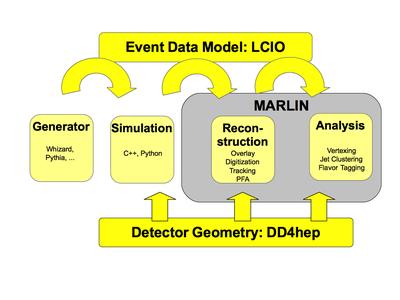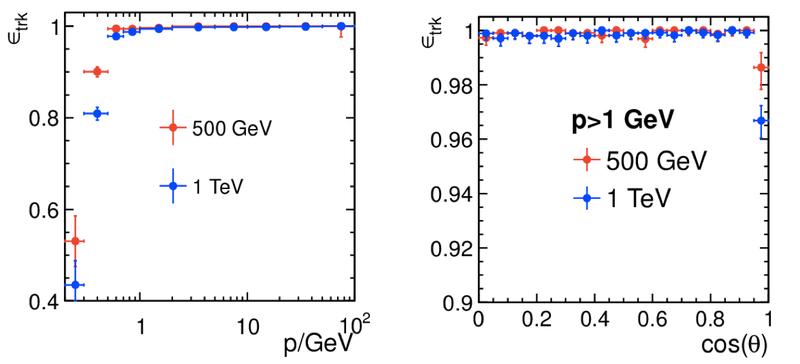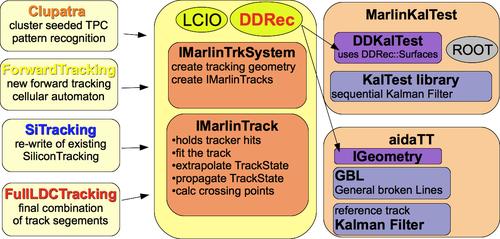Schematic view of the core components in iLCSoft, LCIO, DD4hep and Marlin.
iLCSoft
Research and Technologies for Future Particle Physics Experiments
iLCSoft

Introduction
The design, development and optimization of a new detector for particle physics would not be possible without intensive studies based on detailed simulation, reconstruction and analysis software.
We are one of the leading research groups that develop and maintain the iLCSoft framework that provides the software tools used in the preparation for the International Linear Collider (ILC) and CLIC, as well as for other future accelerator projects. iLCSoft provides a complete framework for studying and optimizing the performance of a proposed detector design. Based on a realistic description of the detector layout and all its components, the detailed simulation of the detector response with Geant4 and the application of sophisticated pattern recognition algorithms, we can create large Monte Carlo data sets that are very close to what physicists will eventually see from a real detector at a linear collider. By carrying out realistic physics analyses on these data sets, we can estimate the performance of the envisaged detector and thereby predict the accuracy of physics measurements that we can expect.
Software Tools
The core components of iLCSoft are the application framework Marlin, the event data model LCIO and the detector geometry description toolkit DD4hep.

LCIO defines a hierarchical event data model with data structures describing the complete physics event, starting from the Monte Carlo truth information over simulated tracker and calorimeter hits to reconstructed objects like tracks, clusters and vertices. The LCIO event data nodel is generic enough to be used throughout the linear collider community for detector concept studies as well as for detector test beam campaigns. It defined the common language for the LC software tools.
Marlin is a modular C++ application framework that allows to write flexible software modules for all stages of the event data processing chain, starting from digitization, over reconstruction to analysis. Marlin used LCIO as its transient event store.
DD4hep
A detailed and realistic description of the detector geometry and material properties is essential for the development of almost all data-processing applications in high energy physics (HEP) experiments. This is particularly evident in Monte Carlo simulations, where the exact knowledge of the position, shape and material content of every detector component is crucial for the accuracy of the simulated detector response and underlying physics. For the subsequent processing steps of digitisation and reconstruction, it is equally important to have an accurate description of the detector geometry, which should ideally be created from the same source to avoid inconsistencies. The DD4hep (Detector Description for HEP) software package is a generic geometry toolkit that builds on the two most widely used software packages in HEP: ROOT and Geant4. Even though DD4hep was developed in the context of the linear collider project with other future accelerator projects in mind, it has been designed from the start to support the full experiment life cycle, meaning that it can be used continuously also beyond the project-planning phase or be adopted by running experiments. DD4hep is developed in a collaboration between CERN and DESY.
MarlinTrk
The reconstruction of the momentum and path of charged particles forms an essential part of data processing in High Energy Physics experiments. The task is typically divided into the two steps of finding the track, the pattern recognition, and in computing the best set of parameters using fitting algorithms such as Kalman-filters or the General Broken Lines (GBL) algorithm. We developed tools for both steps and combined them through the definition of an abstract interface that links both tasks without coupling them directly, allowing the choice of the best combination of pattern recognition and track fitting tools. In order to take material effects like multiple scattering and energy loss into account, detailed knowledge of the detector geometry is essential. This is provided through the DDRec interface into the DD4hep detector model.
Tracking efficiency for ILD
As an exampe for the application of the pattern recognition tools, we can look at the efficency of finding tracks in top-anti-top pair events at the ILC with the ILD detector.

Tracking efficiency for top-anti-top pairs in the ILD detector.
Research and Development
We continuously work on the improvement of the software tools in order to achieve a better overall detector performance and physics reach as well as a better CPU performance.
Topics
- improvement of the pattern recognition algorithms for low pt and very forward tracks
- application of Cellular Automatons
- conformal mapping algorithms
- machine learning techniques
- development of alginment algorithms for iLCSoft and MarlinTrk
- implementation of mis-alignment effects in the DD4hep based detector description
- integration of alignment tools like MillePede in MarlinTrk
- development of an alignment strategy for the ILD detector concept
- determine the necessary luminosity for a complete alginment of the ILD trackers
- cross check with estimates of the expected and needed mechanical stability of tracking detectors
- parallelization of the iLCSoft tools
- parallel track finding and fitting
- parallel event processing in the Marlin framework
- thread safety in LCIO, Marlin and DD4hep
- improvement of the I/O performance in LCIO
- implement a new I/O layer for LCIO based on PODIO
- development of high level reconstruction algorithms
- particle identification
- flavor tagging
- vertexing
Further Documentation
Code and Documentation
- iLCSoft project on GitHub: https://github.com/iLCSoft
